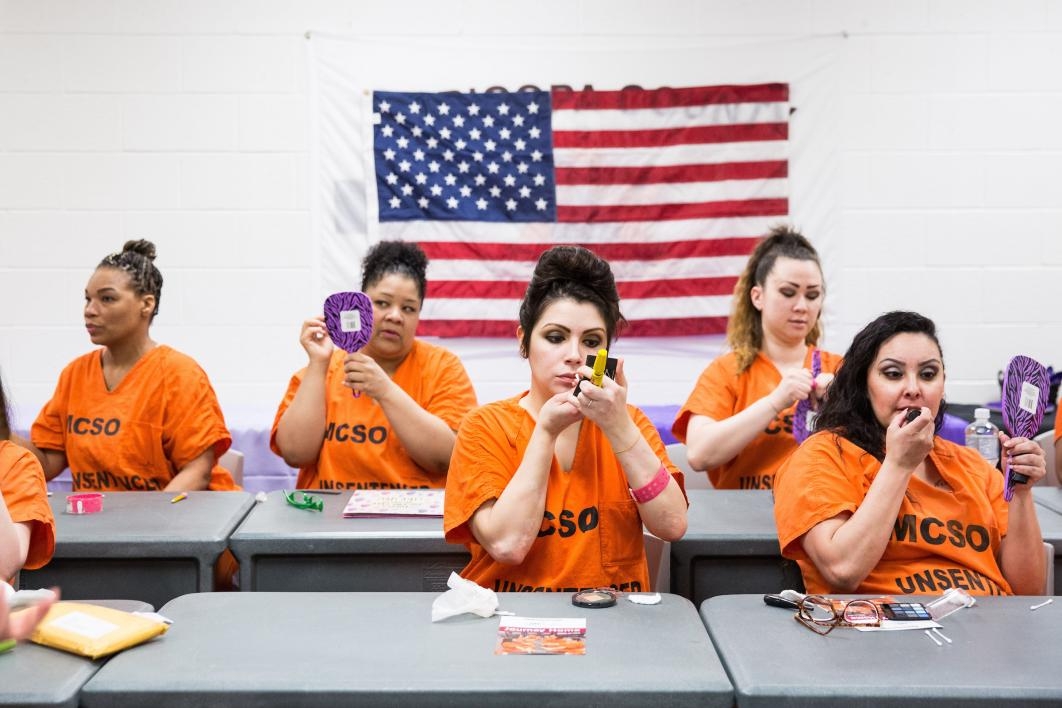My life. My story. My sister. Myself.
Fourteen voices chanted these lines, hands clapping and feet pounding on carpet inside the repurposed chapel of Estrella Jail in Phoenix on Saturday afternoon.
Those fourteen voices came from female inmates, the participants in the ASU Gammage-supported program Journey Home, an arts experience for incarcerated women. The program consists of three weeks of workshops and a final performance chosen by the women and program director Fatimah Halim and choreographer Teniqua Broughton.
In its 19th year, the program varies in each iteration, adapting to its participants. On Saturday the performance resembled a confessional of sorts: Women stood in small groups with their backs turned, then turned one-by-one to face the audience and share a personal experience, asking not for sympathy or reaction, only listening. The stories included the birth of a grandson, addiction, gambling, childhood sexual abuse and the loss of a loved one.
Video by Deanna Dent/ASU Now
SelenaThe inmates' last names are being withheld for their privacy. stands, her slim figure exaggerated inside an oversize orange uniform that reads “Unsentenced” across her waist, and shares a poem about her life. How she became addicted to heroin, following a path that seemed glamorous to a young girl but resulted in the death of her infant child — whom she still prays for.
“I’ve struggled with heroin addiction for the last nine years so this is the longest I’ve been sober, going on six months,” she said. “I’ve never been able to open up about it so through this program I did that.”
Brenda arrived at jail to find out she was five weeks pregnant. She confessed that she found herself overwhelmed by the support and help of her fellow female inmates. She described how the women surprised her with a baby shower, managing to make paper rose decorations and create baby games they could play. She has since had her child, whom she may not see for several years.
“Participating meant having to go through the rough emotions that we were trying to shelter ourselves from,” she said. “It was like a counseling session helping us work through things that we had become professionals at burying.”
For ASU Gammage Executive Director and ASU Vice President for Cultural Affairs Colleen Jennings-Roggensack, the program’s value as a way of bridging communities has been clear since the first performance 19 years ago.
“We all learn from the process, we all learn about what it means to take care of each other, we learn about what it means how to express, how to share, all of the bumps in the road that we all encounter and then how we move forward and make where we are a much better place,” she said.
As the show concluded, Alyssa was asked why she would perform in front of an audience of strangers from outside the jail.
“I wanted to give the audience a little taste of who I am. I wanted to let them know that I’m a mother, a wife, a person, not just an inmate,” she said.
Top photo: Brenda (center) and others perform a dance during the "Journey Home" performance at the Estrella Jail facility on March 24. Photo by Deanna Dent/ASU Now
More Arts, humanities and education

A humanities link from Harvard to ASU
Jeffrey Wilson didn’t specifically seek out Arizona State University professors when it came to filling out the advisory board for his new journal Public Humanities.“It just turns out that the type…

The Design School wins award for impactful design education
Luis Angarita, program head for The Design School’s industrial design program, attended the inaugural Don Norman Design Summit in San Diego to accept the Don Norman Design Award, which honors…

ASU professor’s award-winning book allows her to launch scholarship for children of female shrimp traders in Mexico
When Arizona State University Associate Professor Maria Cruz-Torres set out to conduct the fieldwork for her third book, "Pink Gold," more than 16 years ago, she didn’t count on having major surgery…






